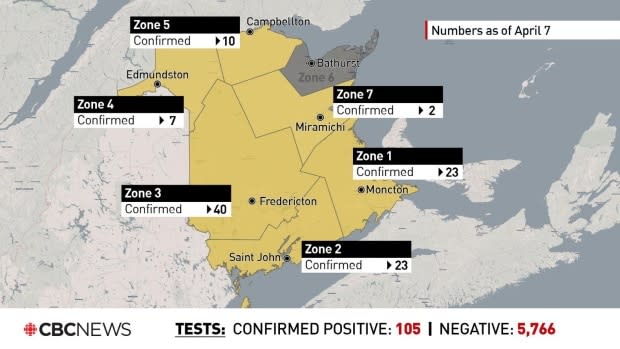Cases of COVID-19 found less frequently in New Brunswick than in other provinces
As some provinces cope with dramatically escalating numbers of COVID-19 cases, New Brunswick continues to show a relative scarcity of infections — even after adjusting for the low level of testing that has been done in the province.
On Tuesday, New Brunswick's chief medical officer of health Dr. Jennifer Russell announced just two new cases of COVID-19 for the second day in a row, bringing the province's total since the beginning of the crisis to 105.
It's a stark contrast to what's been happening in neighbouring provinces.
Over the last five days, Nova Scotia has identified 117 new cases of COVID-19, including 31 on a single day on Monday. During the same period, New Brunswick's total jumped by just 14, with the worst day involving four new infections last Friday.
"We appear to be in many ways faring better than many other jurisdictions," said Russell in her daily briefing Monday.
"Our case numbers have been relatively low. Our hospital admissions have been relatively few. The incidence of community transmission appears to be relatively rare."
Lower testing rates
New Brunswick has tested less for the virus than most provinces, including Nova Scotia, but that has not been the most significant factor generating its low case count.
In testing that has been done, the virus consistently turns up less frequently in New Brunswick than elsewhere — once in every 58 tests since the beginning of the pandemic.
In Nova Scotia, the virus has shown up once in every 35 tests and in Quebec once in every 13 tests.
The ratio of cases to tests in those provinces has further worsened in the last week, but in New Brunswick it has improved.

The 14 new cases found in the province since last Thursday, involved 1,592 tests. That's one infection discovered in every 114 tests.
University of Ottawa epidemiologist Raywat Deonandan said that shift in the numbers is not insignificant.
"Looks like your rate of new case generation has slowed and is dropping," he said in an email about recent results in New Brunswick.
Lower community spread
Deonandan said New Brunswick's published data suggests the province may have escaped some of the "seeding" of the virus other provinces received from international travellers because there has been little community spread detected so far.
"Your low proportion of community spread cases suggests to me that the disease might not be as rampant in New Brunswick as it is in other provinces, possibly due to a lesser flux of earlier travellers," he wrote.
"In Canada as a whole, half of all cases are now due to community spread."
Russell has suggested early decisions by the New Brunswick government to close schools and businesses, ban public gatherings, seal borders and enforce physical distancing may be also be playing a role.

In addition, New Brunswick has a number of natural advantages over other provinces when fighting a pandemic.
A higher percentage of people in the province live at comfortable distances from one another in rural communities, and its urban cores are less dense than in other provinces.
According to Statistics Canada 69.3 per cent of dwellings in New Brunswick are single family homes — well above the national average — while less than two per cent of dwellings are in high rise apartment complexes (more than four storeys). The national number is 10 per cent.
Deonandan said New Brunswick's rural character could very well be helping.
"That would definitely be a factor, especially if it also means lesser frequent 'supply runs' to the stores, and lesser frequency of gathering in places like coffee shops and mass transit," he wrote.


